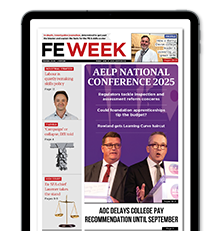The government should think carefully before taking a cliff edge, pass-fail approach to the register of apprenticeship training providers, writes Simon Ashworth
Although the FE white paper contained ideas that have stimulated positive debate, the refresh from April of the Register of Apprenticeship Training Providers (RoATP) has prompted universal dismay and frustration across the sector.
We are still yet to see any coherent or logical argument from the ESFA about why a refresh needs to happen so soon after the last full refresh back in 2019 – and the fact that the RoATP has been closed to mainstream applications for nearly a whole year now.
The white paper describes the independent training provider landscape of approximately 1,250 organisations as “crowded” and “not always deliver[ing] high-quality provision”.
The reference to “crowded” clearly implies by default that the government has decided there are too many providers and therefore the refresh appears to have a baked-in objective of rationalising the choice of providers available to employers.
‘Unfair picture’
The claim that independent training providers (ITPs) do not always “deliver high-quality provision” also paints a rather opaque and unfair picture.
Year-on-year Ofsted’s annual report highlights that 75 to 80 per cent of ITPs deliver ‘good’ or ‘outstanding’ provision which puts them on a par with other types of providers.
Bearing in mind they are numerically the largest type by far, it’s odd that ITPs are singled out on this front in the white paper.
ITPs have led the roll-out of apprenticeships standards since the outset of the Richard Review of Apprenticeships reforms and this has not been an easy transition.
Other provider types have been slower to adopt standards and they may experience similar growing pains as they also move through that same process.
It is well documented that one in four new providers have been judged as making insufficient progress by Ofsted. We have the legacy of the first iteration of RoATP where the entry criteria and the quality bar just were not robust or high enough.
Some new providers then had to up their game or were managed out of the system.
‘Tighter regulatory position’
Iteration two of RoATP, which was a full refresh, was positioned by the ESFA as raising the bar, involving more thorough testing of capacity and capability of providers wanting to deliver apprenticeship training.
The fact that we have another refresh and new criteria to “better determine whether providers have the capability and capacity to be able to deliver these higher-quality apprenticeships” implies the last process was far from a success.
The fact that we have another refresh implies the last process was far from a success
In the latest guidance, the ESFA has pointed towards a tighter regulatory position where at some point providers need to provide more evidence about their capacity and expertise.
The ESFA is considering how this may be required beyond the initial application process, where providers wish to “expand their delivery to new areas”.
This is a strong hint of a move towards the approach we see with the Register of End Point Assessment Organisations. It’s a move away from an open market for providers to deliver any of the 600 plus standards once on the RoATP.
If this is where the process does end up, the ESFA should avoid too much granularity.
Instead, approval to deliver within occupational sector subject areas rather than at individual standard level would form a happy medium.
‘Avoid cliff-edge outcome’
The recent update on how the agency will now measure the financial health of independent training providers sees the welcome inclusion of some pragmatic mitigations on both profitability and borrowing because of the Covid-19 pandemic.
The financial health assessment has been a key facet in the RoATP process and we expect it to feature again this time around.
Last summer AELP alerted officials to concerns about the impact on short-term profitability due to the downturn in activity, and the need for many providers in the sector to utilise the government’s business loan facilities.
So the mitigations show that they have listened and taken this into account.
Before the guidance on the new criteria for RoATP approval is published, the government should avoid any cliff-edge in terms of the outcome.
The refresh itself is not a procurement exercise and therefore it needs to not just have a robust appeals process.
The ESFA needs to operate the process pragmatically to enable providers to submit future evidence to support their application.
Yes, we want a healthy and high quality training provider marketplace, but a binary and arbitrary approach to pass-fail is not what is needed here.









Some good ideas Simon but Sector Subject Areas are only one way of measuring sensible commonality (and arguably not always even that). For example if a provider were to focus on the commercial functions of large organisations – which is often how clients are organised then standards would cut across four or five SSAs 🙁
The ESFA have a lot to answer for. They have almost destroyed apprenticeships in their ‘pursuit of excellence’. The clear agenda of removing ITPs is clear to see. Name one thing the ESFA have done that has helped the sector… I can’t think of one.